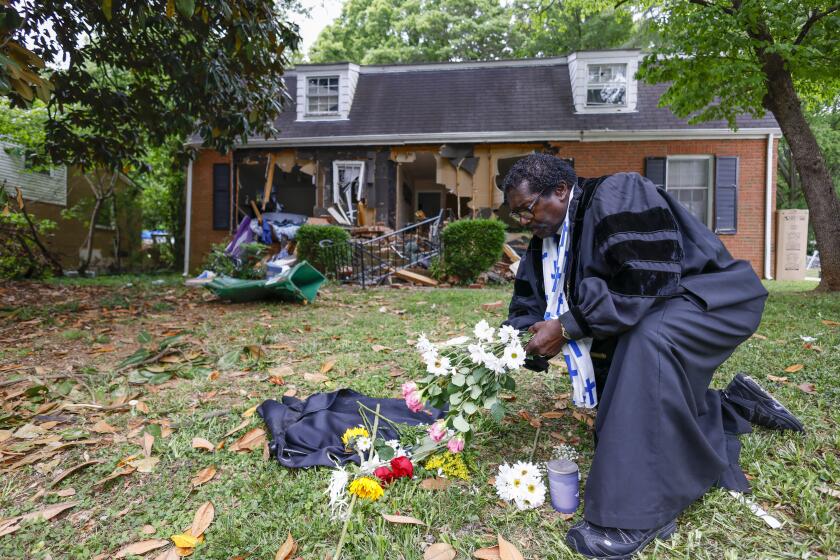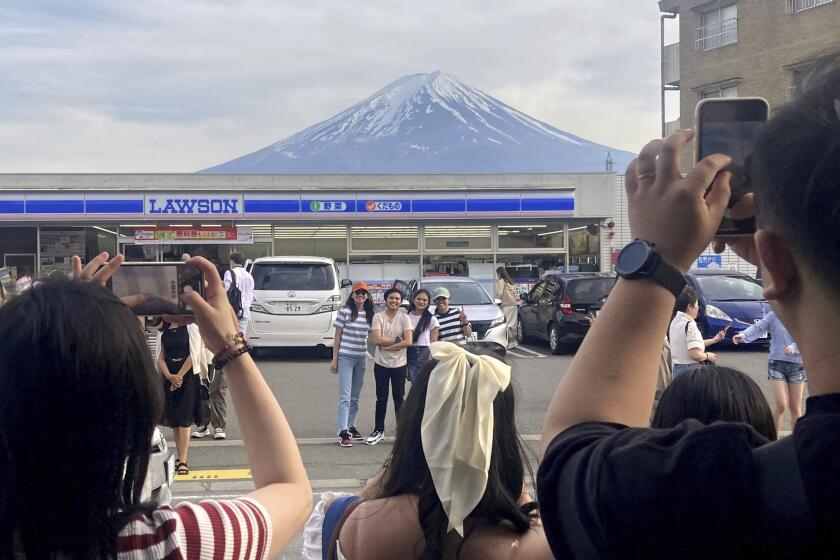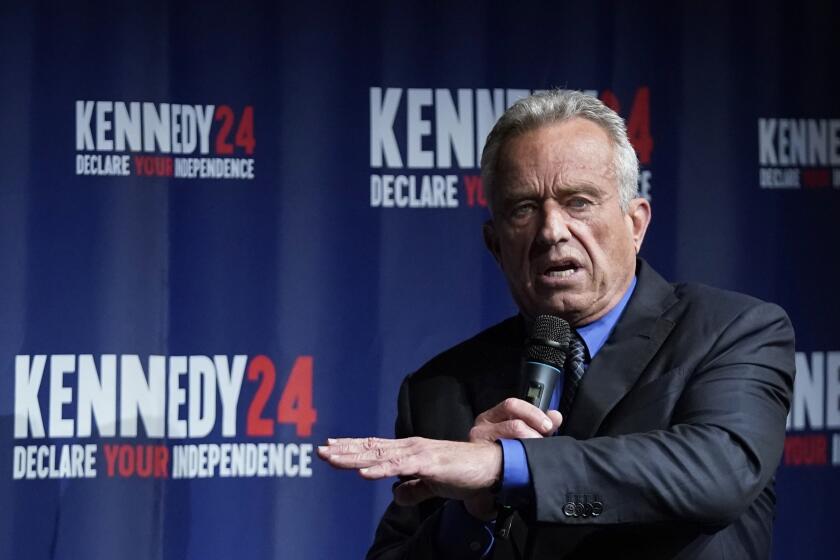A Hard Memory : Rod Ballard’s Death at Velodrome Last Year Brought Rules on Safer Helmets--and a Race That Remembers
Rod Ballard’s death was powerful testimony to the dangers of cycling. As far as the United States Cycling Federation and those with the Encino Velodrome are concerned, he always will be, too.
A year ago Sunday, Ballard was involved in a fatal collision during a three-lap sprint race at the Encino track. The 36-year-old from Brentwood died of massive head injuries three days later at the Northridge Hospital Medical Center.
Racers will remember Ballard--the velodrome’s only fatality in 25 years--in the Rod Ballard Sprint Classic at the velodrome Sept. 13. Henry Ballard, the cyclist’s father, is expected to present trophies to winners at the races, which will become a yearly event.
Only too vividly, racers will also remember the accident in which Ballard was wearing a padded leather helmet. The “hair net” was outlawed four months later, on Jan. 1, by the USCF.
“Rod Ballard was well known. His death was on the lips of everybody,” said Ballard’s friend, Larry Hoffman, who owns a North Hollywood bicycle shop. “The hardshell helmet will probably save a lot of lives, and if not lives, brain damage. You can almost guarantee that.”
Ballard’s collision with Mark Garrett, the other cyclist in the match sprint race, was not that unusual.
Said Paul Schecter, the track director: “We’ve had serious accidents, but never anybody die. Guys go down and break their hips and shoulders.”
Between turns 3 and 4, when Ballard was preparing to take the lead, he and Garrett collided, Ballard flying over his handlebars. Witnesses said that the momentum of the fall caused Ballard to tumble down the cement track for several feet.
“We had more accidents in that month than I can remember in six years of bicycle racing. It can be a dangerous sport,” said Barbara Forgash, a member of the Encino Velodrome Committee, which plans events at the track. “It was highly unusual.”
Next week’s memorial race will bring to memory an unusual September of spills at the Encino Velodrome and across the country.
A week after Ballard crashed, another rider had an accident at the Encino track. Schecter remembers the details.
“Two or three guys came together and one guy went down,” Schecter said. “The guy was wearing an inadequate helmet. He wasn’t a very experienced rider. It was your atypical accident or the guy had a mishap.”
Two weeks later, Tim Bengston, an experienced rider, fell in a race at the track and was taken to Rancho Encino Hospital. A CAT scan revealed a skull fracture. He, too, was not wearing a hardshell helmet--sometimes called a “brain bucket”--which is made out of fiberglass or plastic and provides more protection.
Tim Roach, a friend of Ballard and the cycling director at the Olympic Velodrome at Cal State Dominguez Hills, remembers another incident in Wisconsin that resulted in the death of another cyclist the same week Ballard died.
A cyclist in Kenosha, Wis., was killed instantly in a collision with a semi-trailer truck. The rider was reportedly “slipstreaming” or trailing another vehicle to pick up speed. When he passed the truck at an intersection, he was hit.
“There were two deaths so close together, there was a panic among the rule makers,” Roach said in reference to the helmet issue.
Roach’s wife, Barbara, another close friend of Ballard, plans to race next Saturday for the first time since a June competition in San Diego.
“My main goal is just to participate, not to go out and win,” she said. “I’m coming back in this one for Rod.
Mandating hardshell headgear was something the USCF thought was necessary, Hoffman said, because with hair nets, “if you fall down, they will not protect your head against the impact.
“The SCCF was afraid,” said Hoffman of the Southern California Cycling Federation, a collection of 22 cycling clubs that regularly race at the Encino Velodrome. Fearful of leaving himself open to a liability suit, Hoffman no longer sells “hair nets” as helmets.
“Rod Ballard’s parents probably could’ve sued. The SCCF saw the handwriting on the wall and knew that if they didn’t do something, they’d be leaving themselves open to liability.”
Had Ballard been wearing a hardshell helmet, many people believe he’d still be alive. Still, the cyclist was wearing more than riders do in Europe--where not wearing headgear is an act of machismo, a sign of a rider’s confidence.
“There was a lot of argument over the hardshell,” Hoffman said. “The USCF thought a lot of riders would quit. They thought hardshell helmets were--I’ll try to be polite here--for wimps. I was the first one who said, ‘Let’s make these hardshell helmets mandatory.’ ”
But safer helmets didn’t protect the Encino Velodrome from sky-rocketing insurance premiums. When the track’s policy with National Union ran out on Jan. 15, the USCF didn’t renew it and the track closed. The U.S. Olympic Committee, which set up its own insurance fund for national governing bodies of other sports, negotiated a three-month extension of the USCF’s policy.
When that expired on April 15, the USCF joined the USOC’s group fund. The rate was exorbitant.
“Our projected estimate for liability premiums for the 12 months is about $190,000, as opposed to $22,000,” said USCF District Representative Steve Ball. The first figure represented rates from April ’85 to April ‘86; the second, rates from April ’84 to April ’85.
“That rise certainly can’t be tied to one accident,” Ball said. “What I read in the newspaper is that the insurance companies were taking significant losses and now they’ve regrouped and cut their losses.”
Organizers of rodeo, boxing, and baseball events also found liability insurance much more expensive. Cycling is merely paying for its growing popularity.
“As cycling grows--and it has been growing since the Olympics--there has been an increase in the number of accidents and deaths,” said Rochelle Kaplan, editor of Southwest Cycling magazine. The National Safety Council in Los Angeles doesn’t keep figures on competitive cycling accidents and deaths, according to Bob Bresnahan, a statistics clerk.
“There are very few deaths, mostly because there are very few velodromes,” said John Francis, editor of Cyclist magazine. “There could be 10 or 12 velodromes, no more than that. Deaths are very rare. Broken bones are much more common. Ballard’s death was the first one I’d heard of in the last three or four years, as long as I’ve been covering the sport.”
Kaplan said Ballard’s death appeared to contribute more heavily to raises in insurance rates than it did.
“The U.S. Cycling Federation was pressured by insurance companies to require its cyclists, its members, to wear hardshell helmets,” she said. “It looked like it might have been a cause and effect, but in actuality it was in the works before the death, or else they weren’t going to get any insurance.
“It was necessary because there had been lawsuits as well. The USCF felt it simply had to require that of its members.”
Because of the track’s insurance policy, this is the first year Encino Velodrome officials can remember a ban against training on the track. Only Saturday races with USCF-licensed racers are covered by the track’s policy. No races are held without the USCF’s sanction.
“There always has been an insurance policy that covered everything,” said Ray Joiner, the track announcer. “We used to be able to have beginner’s classes. Now, to offer it, we’d have to send money to Colorado Springs and they’d have to become licensed bicycle racers. Sort of the cart before the horse.”
As a result, Schecter said, “all of our public programs are on hold.”
Before the USCF stepped in, some of the policies the track was offered were stringent.
“By the time you put all the exclusions down, you’re not covered,” Schecter said. “That’s what’s happened to us and everybody has been affected by it.”
The track is open 26 Saturdays, from April to October. On a given date, it averages about 45 racers, each of whom pays $1 for insurance every race. By season’s end, the track will have raised more than $1,100 for the USCF’s insurance costs.
“It’s a sort of pay-as-you-go system,” Forgash said. “Nobody minds paying that dollar.”
And certainly nobody minds paying that dollar for a stronger helmet or for a race to honor Rod Ballard.
More to Read
Start your day right
Sign up for Essential California for news, features and recommendations from the L.A. Times and beyond in your inbox six days a week.
You may occasionally receive promotional content from the Los Angeles Times.






